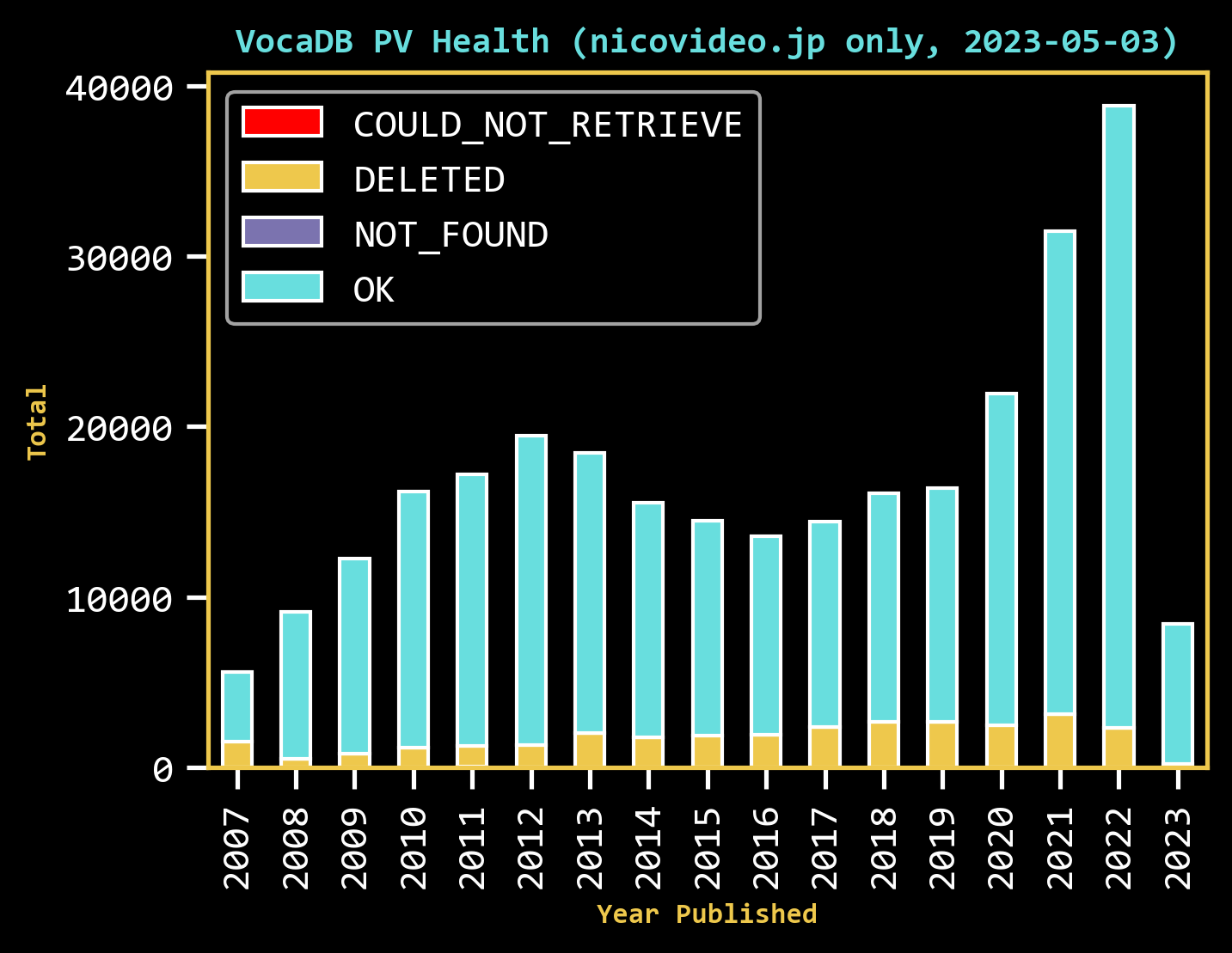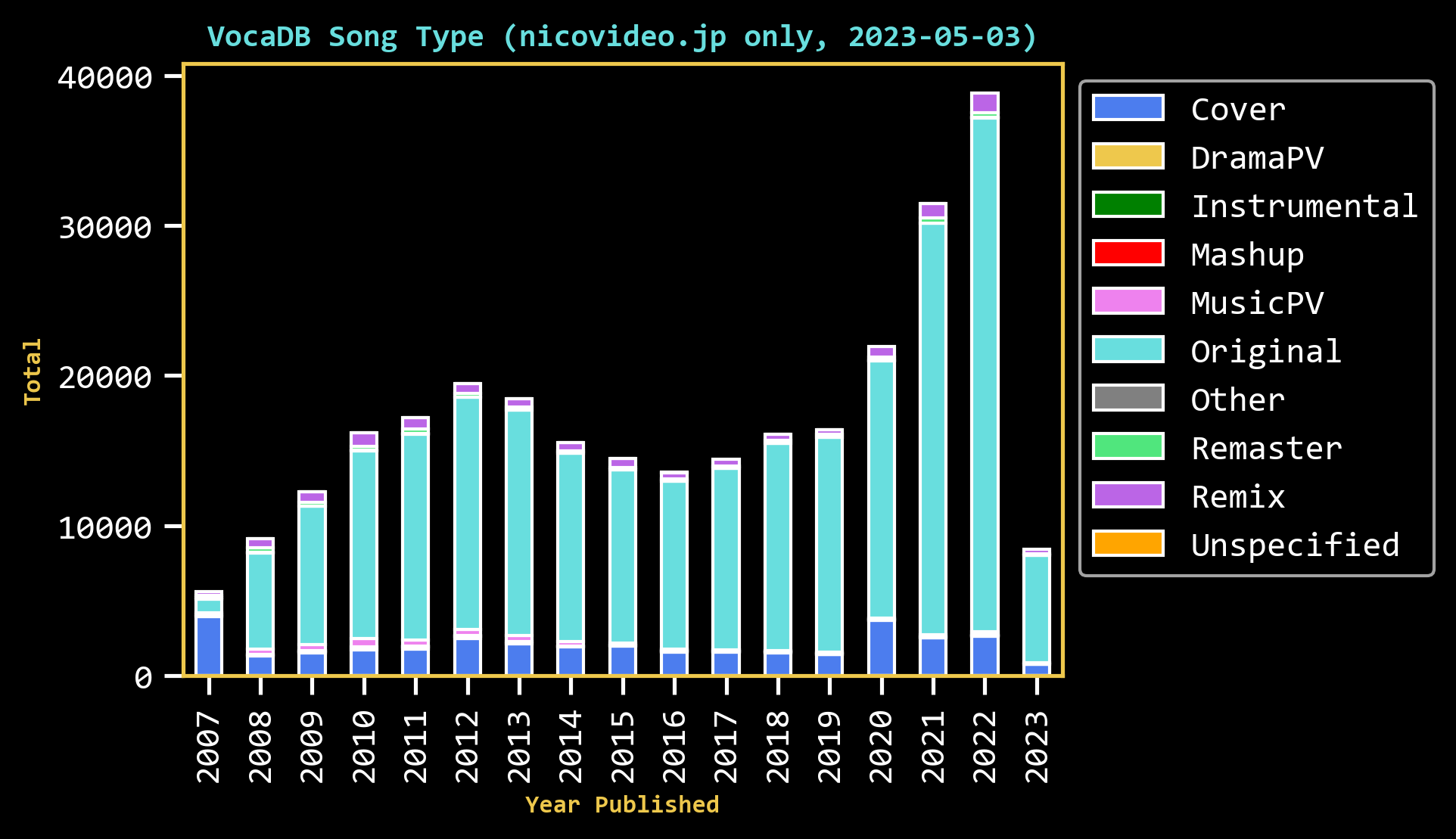vocaloid data rummaging, part 1/?: the disappearance of hatsune miku's links
niconico is a site I love dearly, but is clearly one with a looming expiration date. run by dwango and backed by kadokawa, it’s so far had almost equal longevity to youtube — a rare boast when youtube ate pretty much every other free streaming video site that was its contemporary for lunch — but has also been bleeding user retention and subscriptions for the better part of a decade1. expectations change over 16 years, and people seem to be losing their patience for buffering, low quality viewing hours, and arbitrary favorites limits just for the chance to see scrolling danmaku comments. for now, there’s still enough money to be made in it to keep the lights on, and it still operates as an oasis for specific kinds of niche content for a lot of subcultures that doesn’t get housed anywhere else absorbed nearly as deeply into the site’s DNA. MADs exist on youtube today, but as far as their cult status online is concerned, they really gained prominence for the first time on nico.
prestige does have value, but it’s also a distinction that has limited shelf life on the internet. while google will try to sell you otherwise, vocaloid also sprang to life on nico thanks to a certain android darling that quickly outgrew being a DAW magazine curiosity in 2007. vocaloid originals can be uploaded with reception to youtube today, but nico was where vocaloid was treated as a category and made a focal part of their fan celebration events. while the site may not capture the totality of vocal synth fandom today, it’s still a primary destination for a lot of the creators driving the fandom and has been a reasonable north star for judging how the winds are blowing. right now marks a valuable point in time for both vocaloid and nico: the site captures a tremendous wealth of creator history, is still functionally relevant to the fandom as a whole, and probably most importantly, still exists. watching more japanese services succumb lately, I’ve had an idea come knocking as the years on nico have started to add up: can we learn anything about how fandom operates and changes from scraping a ton of video URLs? I wasn’t really sure, so I decided to suck down a ton of metadata to see what I could learn.
nico video IDs are for the most part all monotonic, meaning they’re stupidly easy for someone like me to scrape. like youtube though, metadata disappears when a video does, so there’s not really much to learn from a link that no longer resolves. fortunately, vocaloid is stewarded by obsessives, and we’ve been cataloging vocaloid uploads and releases for over a decade thanks to vocaDB. this acted as a great seed for discovering relevant video URLs and unlocked a lot of important crowdsourced metadata, like song type, featured vocalists, and plenty of other useful signals. combined with additional metadata scraped for each video from nico and close to 300k videos total, that’s given me a lot to work with!
Covers initially set the stage
hatsune miku’s release in 2007 is effectively the epoch of vocal synth fandom, and that’s most obvious when we take a look at all songs cataloged to vocaDB in aggregate. when miku first released, people weren’t really sure if they should treat vocaloid as a toy or as an instrument, and so a lot of the initial energy around her release was dedicated to seeing what was possible with cover songs. anison covers were a natural fit for a nico audience, so it’s expected that things like echo’s cover of sousei no aquarion and tokiwa’s cover of nagato’s image song were uploaded to good reception quite literally a day after miku’s release.
this was an inherent fact that I internalized a long time ago, but the proportion and scale of covers was actually a little surprising to see. cover songs easily eclipsed the number of original songs being uploaded in 2007 before people had found footing with their own compositions. sousei no aquarion logged 140k views before miku miku ni shite ageru was posted three weeks later, but it’s not something you ever really see invoked alongside it as part of what propelled her popularity.
there are further oddities around this time, like a flawless cover of 4’33 by john cage and a cover of the opening from the 80s drama kita no kuni kara that is entirely hummed. the latter might sound just as benign as the former, but it actually showed off what would be a “killer feature” of vocal synth songs: digital instruments don’t ever need to take a breath. most of the comments here seem to joke at miku’s unmatched lung capacity, which the uploader amended their description to address. it’s a cute demo and not particularly noteworthy on its own, but it developed a technique that you would later see songs like cosmo’s disappearance of miku2 go on to use with great strength.
the prevalence of covers in this initial frenzy is part of what led dwango to ink a formal partnership with JASRAC, japan’s copyright boogeyman, just a few weeks later. there’s actually a good deal more of copyright quackery with nico consistent with this era of online video too, like dwango trying to sell ringtones of miku miku ni shite ageru and attributing “hatsune miku” as the literal artist in a JASRAC filing. that move was met with tremendous backlash that prompted apologies from all parties involved, including crypton for not providing more clarity on copyright pertaining to works created with miku, and some producers of the era characterize this as a sort of catalyst in the trend towards original songs supplanting covers, with creators freely collaborating on composition, arrangement, lyrics, and performances outside of a traditional copyright structure controlled by JASRAC3.
Where did all the covers go?
no matter any copyright deals made yesterday, we stare down the harsh reality of cover songs when we look at video PVs added to vocaDB that no longer lead anywhere today. while covers did make up a greater proportion of songs uploaded during 2007 than at any other time, that year emerges as a relative champion for link rot. keep in mind that vocaDB only began in 2011, meaning all of these links were only ever added after that point. these cover links proved decently stable at least for a few years, but are now internet cobwebs, long after formal agreements and arrangements were made with JASRAC that initially shielded them.
the power of copyright rent-seekers to break links in the short, medium, and long term probably goes without stating if you’ve done any sort of deep dive on the web. while someone may have decided it was worth keeping your cover song up to run ads on it in 2007, someone in 2023 has the power to flip a switch nulling that understanding and to take down your video like a flash flood. evidently, that’s what has happened here when we comb through the videos that are now gone. with four years preceding vocaDB’s inception, there’s also probably no saying how many others were blackholed before they were ever cataloged. it’s a valuable lesson for anyone pursuing secondary doujin creations, especially when they are built on the presumption of flexible creator guidelines or a party’s willingness to turn a blind eye: someone else’s copyright can always come for you.
link rot is usually mentioned in the abstract, as if links spontaneously stop resolving because of some universal half life. copyright takedowns really only exacerbate the greater reality that links as a concept are dying on the web because there’s no value to be extracted from them. there’s almost no reason to care that a link continues to resolve when social media sites are heavily incentivized to downrank external links to begin with, which has never been more naked in twitter’s case. even when those links are surfaced, people don’t click on them or neglect to share them because they experience vertigo being ripped out of a walled garden. search engines too are incapable of wading through SEO spam throwing up referral links, and so the understanding of a link from one page to another has diminishing value even to supposedly world-class algorithms. it is not so much a surprise that 49 percent of the links cited in supreme court decisions now lead nowhere, or that a quarter of vocaloid cover songs from miku’s debut year can go missing, but a sober reminder that no matter how consequential a piece of content can be, it has a tough chance of surviving to maturity online.
-
premium subscriptions peaked in 2016 at 2.5m and have been trending down since, with the latest report ending in 2022 saying there are now just 1.34m active subscriptions ↩
-
as fate would have it, the PV of this song made popular through a youtube reupload is now deleted (https://vocadb.net/S/49710). western fans sometimes attribute this song to some global blocking of miku videos on youtube (that there’s no evidence for), or the actual blackholing of miku searches that happened on yahoo and google as suspected spam, but from everything I’ve ever read cosMo has never attributed that event to the song ↩
-
some gems only shine with context, which you now have for this very funny middle finger: https://www.nicovideo.jp/watch/sm1818997 ↩


